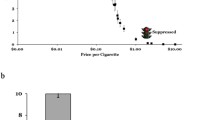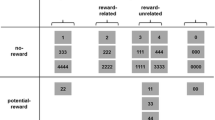Abstract
Two experiments used a dual-task procedure to investigate Tiffany’s (1990) proposal that drug craving should disrupt activities that demand nonautomatic cognitive processing. The primary task required smokers to imagine sentences that incorporated urge or no-urge descriptors. During imagery, the subjects also responded to a secondary reaction time (RT) task. Additional dependent variables collected during the imagery manipulation included craving report, mood report, heart rate (HR), and skin conductance levels (SCL). In study 1, imagery of urge sentences produced slower probe RTs and increases in HR and SCL, greater urge and negative mood reports, and lower positive mood ratings. This same pattern of results was replicated in the second study, which utilized sentence types more closely matched on no-urge content. These results support Tiffany’s (1990) cognitive processing theory and suggest an innovative approach to the investigation of drug craving.
Similar content being viewed by others
References
Brandon TH, Tiffany ST, Baker TB (1987) Characterization of the process of smoking relapse. In: Tims F, Eukefeld C (eds) Relapse and recovery in drug abuse (NIDA Res Monogr 72). US Government Printing Office, Washington DC, pp 104–117
Brandon TH, Piasecki TM, Quinn EP, Baker TB (1995) Cue exposure treatment in nicotine dependence. In: Drummond DC, Tiffany ST, Glautier S, Remington B (eds). Addictive behaviour: Cue exposure theory and practice (The Wiley series in clinical psychology). Wiley, Chichester, England, pp 211–227
Casper PA, Kantowitz BH (1987) Estimating the cost of mental loading in bimodal divided attention tasks: combining reaction time, heart rate variability and signal detection theory. Paper presented at the 1987 Mental State Estimation Workshop, Williamsburg, Va
Cook EW, Atkinson L, Lang KG (1987) Stimulus control and data acquisition for IBM PCs and compatibles. Psychophysiology 24:726–727
Cook EW, Hawk LW, Davis TL, Stevenson VE (1991) Affective individual differences and startle reflex modulation. J Abnorm Psychol 100:5–13
Drobes DJ, Tiffany ST (1996) A comparison of imaginal and cueexposure manipulations of smoking urge: the effect of nicotine deprivation. J Abnorm Psychol (in press)
Droungas A., Childress AR, Ehrman R, Seamans M, O’Brien C (1992), Effect of smoking cues on physiological reactivity, subjective report of craving and Iatency to smoke in smokers. Paper presented at the Fifty-Fourth Annual Scientific Meeting of the College on Problems of Drug Dependency, Keystone, Col
Elash CA, Tiffany ST, Vrana, SR (1995) The manipulation of smoking urges and affect through a brief imagery procedure: selfreport, psychophysiological, and startle probe responses. Exp Clin Psychopharmacol 3:156–162
Ellis HC, Ashbrook PW (1988) Resource allocation model of the effects of depressed mood states on memory. In: Fiedler K, Forgus J (eds) Affect, cognition and social behavior. Hogrefe, Toronto Ontario, pp 25–43
Fowles DC, Christie, MJ, Edelberg, R, Grings, WW, Lykken DT, Venables, PH (1981) Publication recommendations for electrodermal measurements. Psychophysiology 18:232–239
Greenhouse SW, Geisser S (1959) On methods in the analysis of profile data. Psychometrika 24:95–112
Gross MT, Jarvik ME, Rosenblatt MR (1993) Nicotine abstinence produces content-specific Stroop interference. Psychopharmacology 110:333–336
Jarvis M, Russell M, Saloojee Y (1980) Expired air carbon monoxide. A simple breath of tobacco smoke intake. BMJ 281:484–485
Kerr B (1973) Processing demands during mental operations. Mem Cognit 1:401–412
Kahneman D (1973) Attention and effort. Prentice Hall, Englewood Cliffs, New Jersey
Logan GD (1988) Toward and instance theory of automatization. Psychol Rev 95:492–527
Niaura R, Goldstein M, Abrams D (1991) A bioinformational systems perspective on tobacco dependence. Bri J Addict 86:593–597
Norman DA, Shallice T (1985) Attention to action: willed and automatic control of behavior. In: Davidson RJ, Schwartz GE, Shapiro D (eds) Consciousness and self-regulation (Advances in research theory, vol. 4). Plenum Press, New York, pp 2–18
Posner MI, Snyder CR (1975) Attention and cognitive control. In: Solso RL (ed) Information processing and cognition: the Loyola symposium. Wiley New York, pp 55–85
Sayette MA, Hufford MR (1994) Effects of cue exposure and deprivation on cognitive resources in smokers. J Abnorm Psychol 103:812–818
Sayette MA, Monti PM, Rosenhow DJ, Gulliver SB, Colby SM, Sirota AD, Niaura R, Abrams, DB (1994) The effects of exposure on reaction time in male alcoholics. J Stud Alcohol 55:629–633
Spinks J, Kramer A (1991) Capacity views of human information processing: autonomic measures. In: Jennings JR, Coles MGH (eds) Handbook of cognitive psychophysiology; central and autonomic nervous system approaches. Wiley, West Sussex, England, pp 208–228
Tiffany ST (1990) A cognitive model of drug urges and drug use behavior: role of automatic and nonautomatic processes. Psychol Rev 97:147–168
Tiffany ST (1992) A critique of contemporary urge and craving research: methodological, psychometric, and theoretical issues. Addict Behav Res Ther 14:123–139
Tiffany ST (1995): The role of cognitive factors in reactivity to drug urges. In: Drummond DC, Tiffany ST, Glautier S, Remington B (eds) Addiction: cue exposure, theory and practice. Wiley, London, pp 137–165
Tiffany ST, Drobes DJ (1990) Imagery and smoking urges: the manipulation of affective content. Addict Behav 15: 531–539
Tiffany ST, Drobes DJ (1991) The development and initial validation of a questionnaire of smoking urges. Br J Addict 86:1467–1476
Tiffany ST, Hakenwerth DM (1991) The production of smoking urges through an imagery manipulation: psychophysiological and verbal manifestations. Addict Behav 16:389–400
VanOyen-Witvliet C, Vrana SR (1995) Psychophysiological responses as indices of affective dimensions. Psychophysiology 32:436–443
VanOyen-Witvliet CC, Panayiotou AG, Robinson JD, Vrana SR (1994) Emotional imagery: effects of arousal and valence on reaction time and heart rate. Psychophysiology 31:101–105
Vrana SR, Lang PJ (1990) Fear imagery and the startle-probe reflex. J Abnorm Psychol 99:181–189
Wetter DW, Brandon TH, Baker TB (1992) The relation of affective processing measures and smoking motivation indices among college-age smokers. Adv Behav Res Ther 14:169–193
Author information
Authors and Affiliations
Rights and permissions
About this article
Cite this article
Cepeda-Benito, A., Tiffany, S.T. The use of a dual-task procedure for the assessment of cognitive effort associated with cigarette craving. Psychopharmacology 127, 155–163 (1996). https://doi.org/10.1007/BF02805989
Received:
Accepted:
Issue Date:
DOI: https://doi.org/10.1007/BF02805989




